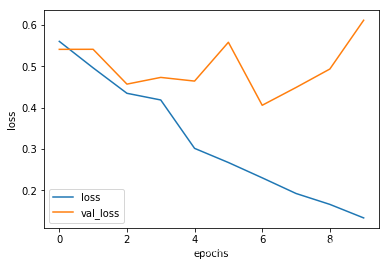TensorFlow2.0チュートリアル - RNNを使用したテキスト分類の実装
オリジナル住所:https://blog.csdn.net/qq_31456593/article/details/89923645
継続的に更新Tensorflow 2.0チュートリアル:https://blog.csdn.net/qq_31456593/article/details/88606284
公式チュートリアル再現性の仕上げノートによって、個々の学習tensorflow2.0にこのチュートリアルで焦点来て、いくつかのメソッドのkerasは、ニューラルネットワークを構築学ぶ、中国は中国のチュートリアル友達に読書を楽しむために簡単に説明するために、tensorflow公式チュートリアル:HTTPS:// WWW .tensorflow.org
完全tensorflow2.0チュートリアルのコードを参照してくださいhttps://github.com/czy36mengfei/tensorflow2_tutorials_chinese(歓迎スター)
Tensorflow2.0チュートリアルコンテンツ:
TensorFlow 2.0チュートリアル- Kerasクイックスタート
TensorFlow 2.0チュートリアル-keras機能のAPI
TensorFlow 2.0チュートリアル-モデルのトレーニングkerasを使用して
kerasとの独自のネットワーク層の構築- 2.0チュートリアルはTensorFlow
TensorFlow 2.0チュートリアル-kerasモデルをしてシリアライズを保存
1.データ入力構成tensorflow_datasets
!pip install -q tensorflow_datasets
[31mspacy 2.0.18 has requirement numpy>=1.15.0, but you'll have numpy 1.14.3 which is incompatible.[0m
[31mplotnine 0.5.1 has requirement matplotlib>=3.0.0, but you'll have matplotlib 2.2.2 which is incompatible.[0m
[31mplotnine 0.5.1 has requirement pandas>=0.23.4, but you'll have pandas 0.23.0 which is incompatible.[0m
[31mneo4j-driver 1.6.2 has requirement neotime==1.0.0, but you'll have neotime 1.7.2 which is incompatible.[0m
[31mmizani 0.5.3 has requirement pandas>=0.23.4, but you'll have pandas 0.23.0 which is incompatible.[0m
[31mfastai 0.7.0 has requirement torch<0.4, but you'll have torch 0.4.1 which is incompatible.[0m
[33mYou are using pip version 10.0.1, however version 19.1 is available.
You should consider upgrading via the 'pip install --upgrade pip' command.[0m
import tensorflow_datasets as tfds
dataset, info = tfds.load('imdb_reviews/subwords8k', with_info=True,
as_supervised=True)
セットのテスト、トレーニングセットを取得します。
train_dataset, test_dataset = dataset['train'], dataset['test']
トークナイザは、文字変換処理ステージIDを使用して、取得する(ここに変換するサブワード、次いでIDに変換)およびその他の操作
tokenizer = info.features['text'].encoder
print('vocabulary size: ', tokenizer.vocab_size)
vocabulary size: 8185
トークンオブジェクトのテスト
sample_string = 'Hello word , Tensorflow'
tokenized_string = tokenizer.encode(sample_string)
print('tokened id: ', tokenized_string)
# 解码会原字符串
src_string = tokenizer.decode(tokenized_string)
print('original string: ', src_string)
tokened id: [4025, 222, 2621, 1199, 6307, 2327, 2934]
original string: Hello word , Tensorflow
各サブワードを解決
for t in tokenized_string:
print(str(t)+'->['+tokenizer.decode([t])+ ']')
4025->[Hell]
222->[o ]
2621->[word]
1199->[ , ]
6307->[Ten]
2327->[sor]
2934->[flow]
トレーニングセットバッチの構築
BUFFER_SIZE=10000
BATCH_SIZE = 64
train_dataset = train_dataset.shuffle(BUFFER_SIZE)
train_dataset = train_dataset.padded_batch(BATCH_SIZE, train_dataset.output_shapes)
test_dataset = test_dataset.padded_batch(BATCH_SIZE, test_dataset.output_shapes)
モデル構築
ここの文章は可変長であるため、ここでは、あなただけのモデルのシーケンスを使用することができますが、APIのkerasの機能を使用することはできません
# def get_model():
# inputs = tf.keras.Input((1240,))
# emb = tf.keras.layers.Embedding(tokenizer.vocab_size, 64)(inputs)
# h1 = tf.keras.layers.Bidirectional(tf.keras.layers.LSTM(64))(emb)
# h1 = tf.keras.layers.Dense(64, activation='relu')(h1)
# outputs = tf.keras.layers.Dense(1, activation='sigmoid')(h1)
# model = tf.keras.Model(inputs, outputs)
# return model
def get_model():
model = tf.keras.Sequential([
tf.keras.layers.Embedding(tokenizer.vocab_size, 64),
tf.keras.layers.Bidirectional(tf.keras.layers.LSTM(64)),
tf.keras.layers.Dense(64, activation='relu'),
tf.keras.layers.Dense(1, activation='sigmoid')
])
return model
model = get_model()
model.compile(loss='binary_crossentropy',
optimizer='adam',
metrics=['accuracy'])
モデルのトレーニング
history = model.fit(train_dataset, epochs=10,
validation_data=test_dataset)
Epoch 1/10
391/391 [==============================] - 827s 2s/step - loss: 0.5606 - accuracy: 0.7068 - val_loss: 0.0000e+00 - val_accuracy:
....
Epoch 10/10
391/391 [==============================] - 791s 2s/step - loss: 0.1333 - accuracy: 0.9548 - val_loss: 0.6117 - val_accuracy: 0.8199
# 查看训练过程
import matplotlib.pyplot as plt
def plot_graphs(history, string):
plt.plot(history.history[string])
plt.plot(history.history['val_'+string])
plt.xlabel('epochs')
plt.ylabel(string)
plt.legend([string, 'val_'+string])
plt.show()
plot_graphs(history, 'accuracy')

plot_graphs(history, 'loss')

テスト
test_loss, test_acc = model.evaluate(test_dataset)
print('test loss: ', test_loss)
print('test acc: ', test_acc)
391/Unknown - 68s 174ms/step - loss: 0.6117 - accuracy: 0.8199test loss: 0.6117385012262008
test acc: 0.81988
上記のモデルは、トレーニング、テスト、無パディングシーケンスを見つけるための列にパディングがある場合には、バイアスすることができ、パディングシーケンスをマスクしません。
def pad_to_size(vec, size):
zeros = [0] * (size-len(vec))
vec.extend(zeros)
return vec
def sample_predict(sentence, pad=False):
tokened_sent = tokenizer.encode(sentence)
if pad:
tokened_sent = pad_to_size(tokened_sent, 64)
pred = model.predict(tf.expand_dims(tokened_sent, 0))
return pred
# 没有padding的情况
sample_pred_text = ('The movie was cool. The animation and the graphics '
'were out of this world. I would recommend this movie.')
predictions = sample_predict(sample_pred_text, pad=False)
print(predictions)
[[0.2938048]]
# 有paddin的情况
sample_pred_text = ('The movie was cool. The animation and the graphics '
'were out of this world. I would recommend this movie.')
predictions = sample_predict(sample_pred_text, pad=True)
print (predictions)
[[0.42541984]]
もっと積層LSTM
from tensorflow.keras import layers
model = keras.Sequential(
[
layers.Embedding(tokenizer.vocab_size, 64),
layers.Bidirectional(layers.LSTM(64, return_sequences=True)),
layers.Bidirectional(layers.LSTM(32)),
layers.Dense(64, activation='relu'),
layers.Dense(1, activation='sigmoid')
])
model.compile(loss=tf.keras.losses.binary_crossentropy,
optimizer=tf.keras.optimizers.Adam(),
metrics=['accuracy'])
history=model.fit(train_dataset, epochs=6, validation_data=test_dataset)
Epoch 1/6
391/391 [==============================] - 1646s 4s/step - loss: 0.5270 - accuracy: 0.7414 - val_loss: 0.0000e+00 - val_accuracy:
....
Epoch 6/6
391/391 [==============================] - 1622s 4s/step - loss: 0.1619 - accuracy: 0.9430 - val_loss: 0.5484 - val_accuracy: 0.7808
plot_graphs(history, 'accuracy')

plot_graphs(history, 'loss')

res = model.evaluate(test_dataset)
print(res)
391/Unknown - 125s 320ms/step - loss: 0.5484 - accuracy: 0.7808[0.5484032468570162, 0.78084]
